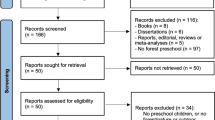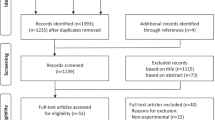Abstract
Child health and development benefit from physical activity. This analysis describes the residential play environment for children aged 2–4 years in farmworker families, their parent-reported levels of play and media time, and the association of residential environment with play and media time. Mothers with a child aged 2–4 years in farmworker families (n = 248) completed interviews over 2 years. Outcome measures were daily outdoor play time and media time. Measures of the residential environment included physical and social components. The mean min/day for outdoor play was 81.8 (SD 57.3) at baseline, 111.4 (SD 90.1) at year 1 follow-up, and 103.6 (SD 76.2) at year 2 follow-up. The mean media min/day at baseline was 83.8 (SD 64.3), 93.7 (SD 80.3) min/day at year 1 follow-up, and 59.9 min/day (SD (45.6) at year 2 follow-up. One additional person per bedroom was associated with 6 fewer min/day with media. The addition of each age appropriate toy was associated with an additional 12.3 min/day of outdoor play. An additional type of inappropriate media was associated with 6.8 more min/day with media. These results suggest changes to the residential environment to improve physical activity among children in Latino farmworker families.
Similar content being viewed by others
References
Janssen I, Leblanc AG. Systematic review of the health benefits of physical activity and fitness in school-aged children and youth. Int J Behav Nutr Phys Act. 2010;7:40.
Loprinzi PD, Cardinal BJ, Loprinzi KL, Lee H. Benefits and environmental determinants of physical activity in children and adolescents. Obes Facts. 2012;5(4):597–610.
Roberts JD, Ray R, Biles AD, Knight B, Saelens BE. Built environment and active play among Washington DC metropolitan children: a protocol for a cross-sectional study. Arch Public Health. 2015;73(1):22.
Tandon P, Grow HM, Couch S, et al. Physical and social home environment in relation to children’s overall and home-based physical activity and sedentary time. Prev Med. 2014;66:39–44.
Thompson DA, Tschann JM. Factors contributing to background television exposure in low-income Mexican–American preschoolers. Matern Child Health J. 2016. (Epub ahead of print).
Conlon BA, McGinn AP, Lounsbury DW, Diamantis PM, Groisman-Perelstein AE, Wylie-Rosett J, Isasi CR. The role of parenting practices in the home environment among underserved youth. Child Obes. 2015;11(4):394–405.
Kurka JM, Adams MA, Todd M, et al. Patterns of neighborhood environment attributes in relation to children’s physical activity. Health Place. 2015;34:164–70.
Moore JB, Beets MW, Morris SF, Kolbe MB. Comparison of objectively measured physical activity levels of rural, suburban, and urban youth. Am J Prev Med. 2014;46(3):289–92.
Grzywacz JG, Arcury TA, Trejo G, Quandt SA. Latino mothers in farmworker families’ beliefs about preschool children’s physical activity and play. J Immigr Minor Health. 2016;18(1):234–42.
Ip EH, Saldana S, Trejo G, et al. Physical activity states of preschool-aged Latino children in farmworker families: predictive factors and relationship with BMI percentile. J Phys Act Health. 2016. (Epub ahead of print).
Salmon J, Veitch J, Abbott G, et al. Are associations between the perceived home and neighbourhood environment and children’s physical activity and sedentary behaviour moderated by urban/rural location? Health Place. 2013;24:44–53.
Ogden CL, Carroll MD, Kit BK, Flegal KM. Prevalence of childhood and adult obesity in the United States, 2011–2012. JAMA. 2014;311(8):806–14.
Kumanyika SK, Grier S. Targeting interventions for ethnic minority and low-income populations. Future Child. 2006;16(1):187–207.
Trost SG, McCoy TA, Vander Veur SS, Mallya G, Duffy ML, Foster GD. Physical activity patterns of inner-city elementary schoolchildren. Med Sci Sports Exerc. 2013;45:470–4.
Wong WW, Ortiz CL, Lathan D, et al. Underserved minority children are not meeting the US public health recommendation for moderate-vigorous physical activity. J Obes Weight Loss Ther. 2012;2(4):132.
Nichols M, Stein AD, Wold JL. Health status of children of migrant farm workers: farm worker family health program, Moultrie, Georgia. Am J Public Health. 2014;104(2):365–70.
Rosado JI, Johnson SB, McGinnity KA, Cuevas JP. Obesity among Latino children within a migrant farmworker community. Am J Prev Med. 2013;44(3 Suppl 3):s274–81.
Grzywacz JG, Suerken CK, Roblyer Zapata, et al. Physical activity of preschool-aged Latino children in farmworker families. Am J Health Behav. 2014;38(5):717–25.
Arcury TA, Skelton JA, Ip EH, Suerken CK, Trejo G, Quandt SA. Anticipatory guidance about child diet and physical activity for Latino farmworker mothers. J Health Care Poor Underserved. 2016. (in press).
Arcury TA, Quandt SA. Delivery of health services to migrant and seasonal farmworkers. Annu Rev Public Health. 2007;28:345–63.
Quandt SA. Health of children and women in the farmworker community in the eastern United States. In: Arcury TA, Quandt SA, editors. Latino farmworkers in the Eastern United States: health, safety, and justice. New York, NY: Springer; 2009. p. 173–200.
Carroll D, Samardick RM, Bernard S, Gabbard S, Hernandez T. Findings from the National Agricultural Workers Survey (NAWS) 2001–2002. A demographic and employment profile of United States farm workers. Research Report No. 9. Washington, DC: US Department of Labor, Office of the Assistant Secretary for Policy, Office of Programmatic Policy; 2005.
Early J, Davis SW, Quandt SA, Rao P, Snively BM, Arcury TA. Housing characteristics of farmworker families in North Carolina. J Immigr Minor Health. 2006;8(2):173–84.
Gentry AL, Grzywacz JG, Quandt SA, Davis SW, Arcury TA. Housing quality among North Carolina farmworker families. J Agric Saf Health. 2007;13(3):323–37.
Vallejos QM, Quandt SA, Arcury TA. The condition of farmworker housing in the eastern United States. In: Arcury TA, Quandt SA, editors. Latino farmworkers in the Eastern United States: health, safety, and justice. New York, NY: Springer; 2009. p. 37–69.
Vallejos QM, Quandt SA, Grzywacz JG, et al. Migrant farmworkers’ housing conditions across an agricultural season in North Carolina. Am J Ind Med. 2011;54(7):533–44.
Arcury TA, Trejo G, Suerken CK, Grzywacz JG, Ip EH, Quandt SA. Housing and neighborhood characteristics and Latino farmworker family well-being. J Immigr Minor Health. 2015;17(5):1458–67.
Arcury TA, Trejo G, Suerken CK, Ip EH, Quandt SA. Stability of household and housing characteristics among farmworker families in North Carolina: implications for health. J Immigr Minor Health. 2016. (Epub ahead of print).
Keim-Malpass J, Spears Johnson CR, Quandt SA, Arcury TA. Perceptions of housing conditions among migrant farmworkers and their families: implications for health, safety and social policy. Rural Remote Health. 2015;15:3076.
Shores KA, Moore JB, Yin Z. An examination of triple jeopardy in rural youth physical activity participation. J Rural Health. 2010;26(4):352–60.
Arcury TA, Quandt SA. Participant recruitment for qualitative research: a site-based approach to community research in complex societies. Hum Organ. 1999;58(2):128–33.
Johnson RK. Dietary intake—How do we measure what people are really eating? Obes Res. 2002;10(Suppl 1):63S–8S.
Spurrier NJ, Magarey AA, Golley R, Curnow F, Sawyer MG. Relationships between the home environment and physical activity and dietary patterns of preschool children: a cross-sectional study. Int J Behav Nutr Phys Act. 2008;5(1):31.
Sallis JF, Nader PR, Broyles SL, et al. Correlates of physical activity at home in Mexican–American and Anglo-American preschool children. Health Psychol. 1993;12(5):390–8.
Hinkley T, Crawford D, Salmon J, Okely AD, Hesketh K. Preschool children and physical activity: a review of correlates. Am J Prev Med. 2008;34(5):435–41.
Umstattd Meyer MR, Moore JB, Abildso C, Edwards MB, Gamble A, Baskin ML. Rural active living: a call to action. J Public Health Manage Pract. 2015. (Epub ahead of print).
Burdette HL, Whitaker RC, Daniels SR. Parental report of outdoor playtime as a measure of physical activity in preschool-aged children. Arch Pediatr Adolesc Med. 2004;158(4):353–7.
Oliver M, Schofield GM, Kolt GS. Physical activity in preschoolers: understanding prevalence and measurement issues. Sports Med. 2007;37(12):1045–70.
Duch H, Fisher EM, Ensari I, et al. Association of screen time use and language development in Hispanic toddlers: a cross-sectional and longitudinal study. Clin Pediatr (Phila). 2013;52(9):857–65.
Council on Communications and Media. Children, adolescents, and the media. Pediatrics. 2013;132(5):958–61.
Raustorp A, Pagels P, Boldemann C, Cosco N, Soderstrom M, Martensson F. Accelerometer measured level of physical activity indoors and outdoors during preschool time in Sweden and the United States. J Phys Act Health. 2012;9(6):801–8.
Cleland V, Crawford D, Baur LA, Hume C, Timperio A, Salmon J. A prospective examination of children’s time spent outdoors, objectively measured physical activity and overweight. Int J Obes (Lond). 2008;32(11):1685–93.
Alhassan S, Sirard JR, Robinson TN. The effects of increasing outdoor play time on physical activity in Latino preschool children. Int J Pediatr Obes. 2007;2(3):153–8.
Cardon G, Van Cauwenberghe E, De Bourdeaudhuij I. What do we know about physical activity in infants and toddlers: a review of the literature and future research directions. Sci Sports. 2011;26(3):127–30.
Troiano RP, Berrigan D, Dodd KW, Masse LC, Tilert T, McDowell M. Physical activity in the United States measured by accelerometer. Med Sci Sports Exerc. 2008;40(1):181–8.
Dennison BA, Erb TA, Jenkins PL. Television viewing and television in bedroom associated with overweight risk among low-income preschool children. Pediatrics. 2002;109(6):1028–35.
Tandon PS, Zhou C, Sallis JF, Cain KL, Frank LD, Saelens BE. Home environment relationships with children’s physical activity, sedentary time, and screen time by socioeconomic status. Int J Behav Nutr Phys Act. 2012;9:88.
Moore JB, Jilcott SB, Shores KA, Evenson KR, Brownson RC, Novick LF. A qualitative examination of perceived barriers and facilitators of physical activity for urban and rural youth. Health Educ Res. 2010;25(2):355–67.
Funding
This research was supported by a grant from the Eunice Kennedy Shriver National Institute of Child Health and Human Development (R01 HD059855). Dietary data analysis was supported by a grant to University of North Carolina Chapel Hill from the National Institute of Diabetes and Digestive and Kidney Diseases (P30 DK56350).
Author information
Authors and Affiliations
Corresponding author
Ethics declarations
Conflict of interest
The authors declares that they have no conflicts of interest.
Ethical Approval
All procedures performed in studies involving human participants were in accordance with the ethical standards of the institutional and/or national research committee and with the 1964 Helsinki declaration and its later amendments or comparable ethical standards.
Rights and permissions
About this article
Cite this article
Arcury, T.A., Suerken, C.K., Ip, E.H. et al. Residential Environment for Outdoor Play Among Children in Latino Farmworker Families. J Immigrant Minority Health 19, 267–274 (2017). https://doi.org/10.1007/s10903-016-0473-4
Published:
Issue Date:
DOI: https://doi.org/10.1007/s10903-016-0473-4




